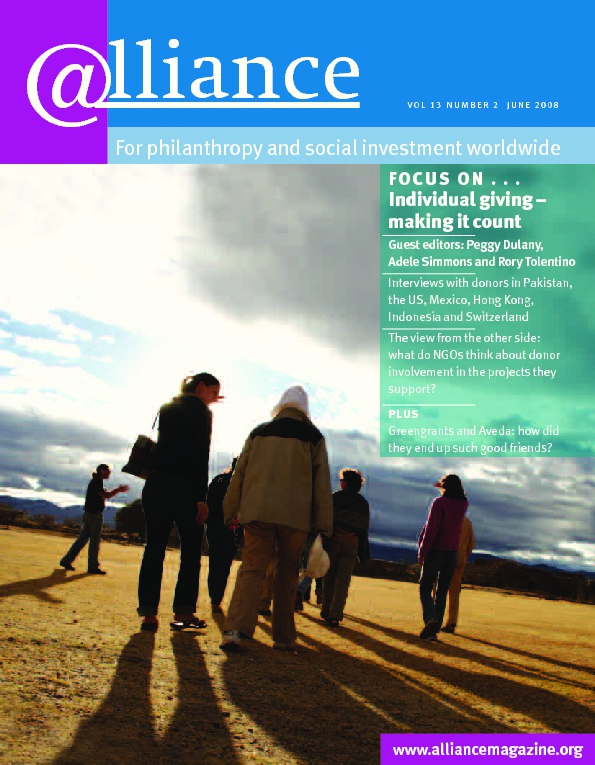Ginny Jordan, Devin Hibbard and Torkin Wakefield founded BeadforLife in September 2004. They first met the women rolling beads – refugees from war in Uganda, struggling to feed their families on less than a dollar a day – just five months earlier. They took several hundred necklaces back to North America with them and found people liked the beads – ‘they were pretty’. But they also found ‘a real hunger for the stories of these women’. In November, Oprah magazine ran 200 words on BeadforLife. It was in the Christmas edition and $90,000 worth of sales came through the website in just six weeks. ‘We realized we had an organization that could blossom.’
BeadforLife now has 30 staff, while the 300 bead makers are independent contractors. For two years these women earn four to seven times what they earned previously. In addition to income generation and a savings programme, BeadforLife offers assistance in three other areas that are critical to help people escape extreme poverty: health, affordable housing, and sustainable livelihood and business skills – which they will need if they are to become self-sustaining when they graduate from BeadforLife. ‘The idea is not for BeadforLife to be an indefinite income source for a small group of women but a ladder to escape extreme poverty.’ The first 90 women graduated early in 2008, and many have now launched alternative businesses.
One thing that is remarkable about BeadforLife is the very small initial donor input that was needed to create something very successful. Ginny Jordan gave a small donation to hire someone to look at the business possibilities and draw up a business plan. ‘I do lots of philanthropic things,’ says Jordan. ‘This is the first time I’ve given so little money and made such a major thing happen.’ Since then the organization has been basically self-funding – though, as Devin Hibbard says, ‘Ginny has been incredibly generous with donations for additional special projects.’
But Ginny Jordan is not the only one who contributes to the special projects. BeadforLife now has what they call a ‘bead circle’ of 20,000 people around the world who they can approach for funding for special projects like vocational training. ‘There is this huge community poised to contribute.’
Jordan emphasizes that BeadforLife’s mission has been twofold from the beginning: to get women out of poverty in Uganda, and to educate and engage people in North America by sharing ‘the reality of extreme poverty and what it’s like to live on less than a dollar a day’. Last year over 1,800 ‘BeadParties’ were held, giving people the opportunity not only to buy jewellery but also to learn about poverty and partner with Ugandan women to allow them to lift their families from poverty. The beauty of it is that ‘the initial ask is not to write a cheque but to come and buy beautiful beads made by women helping themselves out of poverty. This is a wonderful currency for raising resources.’ The people who come to buy beads hear the women’s stories – presented via a ten-minute DVD – and often end up as donors as well as buyers. ‘People tell us they feel honoured to participate. It really is a circle of exchange in which everyone benefits,’ says Jordan.
Jordan’s own practical involvement has been largely at the North American end. She is president of the board but when things are busy she mucks in, counting beads, packing boxes and so on – in addition to carrying out the more standard board president roles. She readily admits that the work has been ‘more time-consuming than any of us had thought’.
What have been the main influences on her as a donor? First and foremost, she says, her experience as a board member of the family foundation, the Cricket Island Foundation, whose mission is working with youth and leadership and multi-generational learning. One of the things she has taken from this is the importance of ‘serious evaluation of what works and what doesn’t’. But her role with BeadforLife is very different from sitting in a boardroom and analysing projects. ‘We are right in the midst of it, learning as we go.’
The biggest issue for donors, in her view, is isolation: ‘You’re ready to engage, you need organizations for creative collaboration. If you can team up with other people, your dollars can achieve more.’
How do donors make connections? That’s a big gap, she says. Giving circles, the Global Philanthropists Circle and so on are beginning to meet the need. ‘But are they available for those with more modest wealth?’ In a way BeadforLife is filling exactly this gap.
For more information
http://www.beadforlife.org





Comments (0)